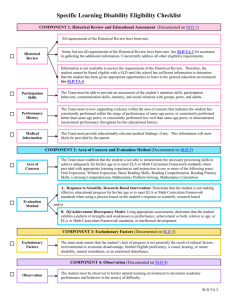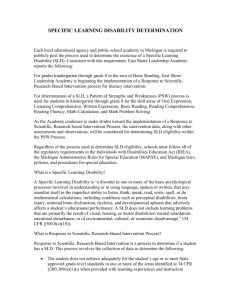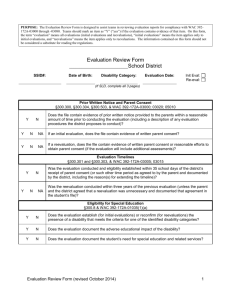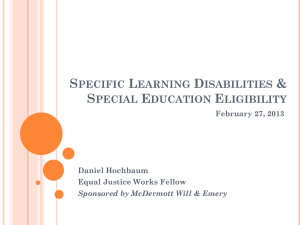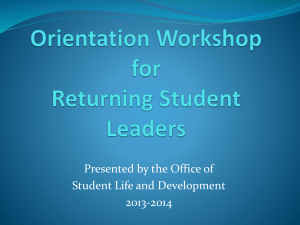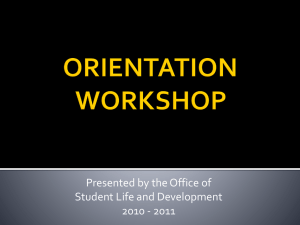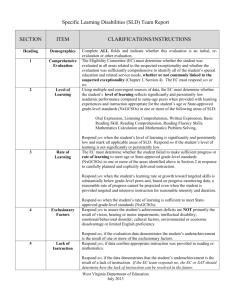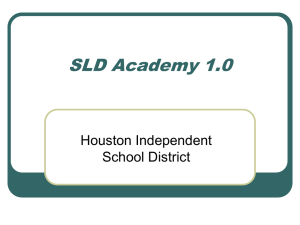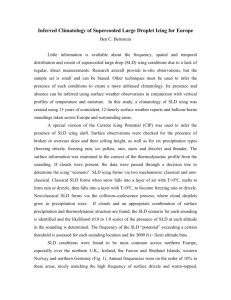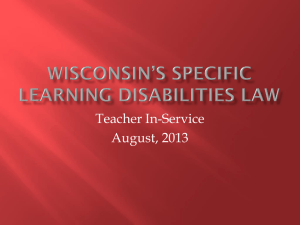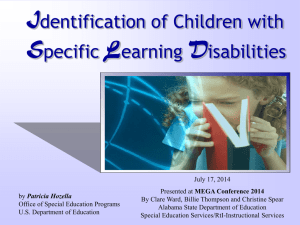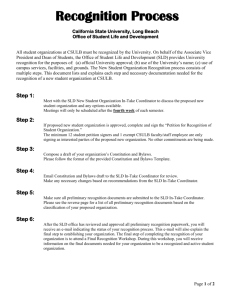SLD Eligibility Requirements Instructions (SLD TA 1)
advertisement
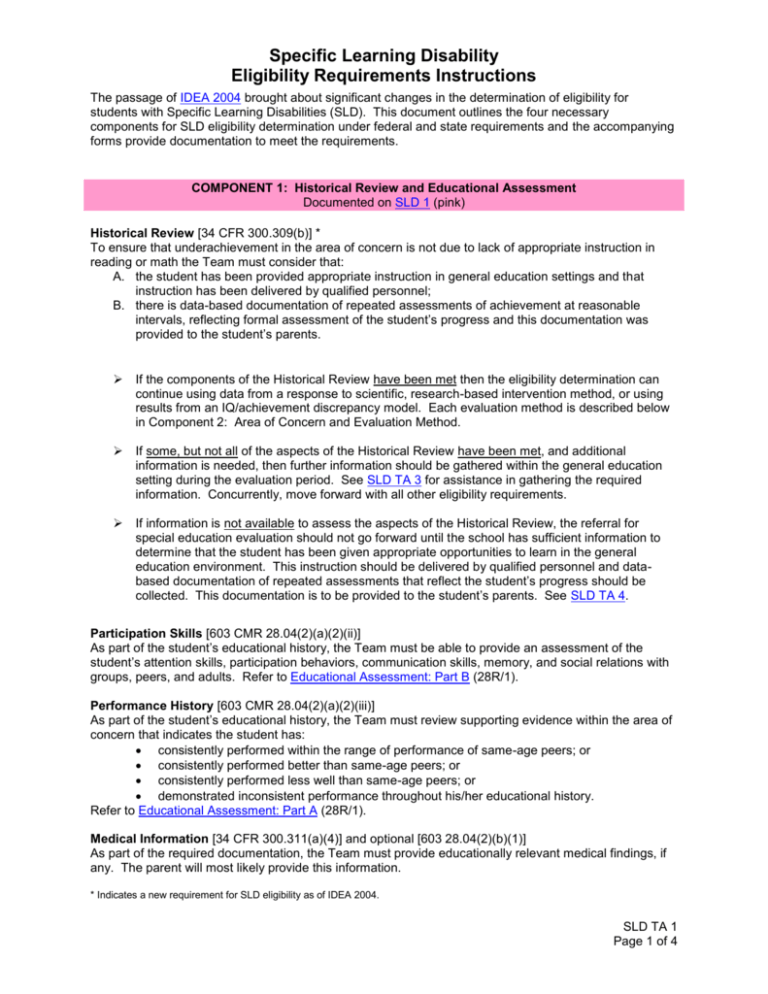
Specific Learning Disability Eligibility Requirements Instructions The passage of IDEA 2004 brought about significant changes in the determination of eligibility for students with Specific Learning Disabilities (SLD). This document outlines the four necessary components for SLD eligibility determination under federal and state requirements and the accompanying forms provide documentation to meet the requirements. COMPONENT 1: Historical Review and Educational Assessment Documented on SLD 1 (pink) Historical Review [34 CFR 300.309(b)] * To ensure that underachievement in the area of concern is not due to lack of appropriate instruction in reading or math the Team must consider that: A. the student has been provided appropriate instruction in general education settings and that instruction has been delivered by qualified personnel; B. there is data-based documentation of repeated assessments of achievement at reasonable intervals, reflecting formal assessment of the student’s progress and this documentation was provided to the student’s parents. If the components of the Historical Review have been met then the eligibility determination can continue using data from a response to scientific, research-based intervention method, or using results from an IQ/achievement discrepancy model. Each evaluation method is described below in Component 2: Area of Concern and Evaluation Method. If some, but not all of the aspects of the Historical Review have been met, and additional information is needed, then further information should be gathered within the general education setting during the evaluation period. See SLD TA 3 for assistance in gathering the required information. Concurrently, move forward with all other eligibility requirements. If information is not available to assess the aspects of the Historical Review, the referral for special education evaluation should not go forward until the school has sufficient information to determine that the student has been given appropriate opportunities to learn in the general education environment. This instruction should be delivered by qualified personnel and databased documentation of repeated assessments that reflect the student’s progress should be collected. This documentation is to be provided to the student’s parents. See SLD TA 4. Participation Skills [603 CMR 28.04(2)(a)(2)(ii)] As part of the student’s educational history, the Team must be able to provide an assessment of the student’s attention skills, participation behaviors, communication skills, memory, and social relations with groups, peers, and adults. Refer to Educational Assessment: Part B (28R/1). Performance History [603 CMR 28.04(2)(a)(2)(iii)] As part of the student’s educational history, the Team must review supporting evidence within the area of concern that indicates the student has: consistently performed within the range of performance of same-age peers; or consistently performed better than same-age peers; or consistently performed less well than same-age peers; or demonstrated inconsistent performance throughout his/her educational history. Refer to Educational Assessment: Part A (28R/1). Medical Information [34 CFR 300.311(a)(4)] and optional [603 28.04(2)(b)(1)] As part of the required documentation, the Team must provide educationally relevant medical findings, if any. The parent will most likely provide this information. * Indicates a new requirement for SLD eligibility as of IDEA 2004. SLD TA 1 Page 1 of 4 Specific Learning Disability Eligibility Requirements Instructions COMPONENT 2: Area of Concern and Evaluation Method Documented on SLD 2 (blue) Area of Concern [34 CFR 300.309(a)(1)] To determine the existence of a SLD the Team must establish that the student is not able to demonstrate the necessary processing skills to achieve adequately for his/her age or to meet ELA or Math Curriculum Framework standards when provided with appropriate learning experiences and instruction in one or more of the following areas: Oral Expression Written Expression Basic Reading Skills Reading Comprehension Reading Fluency Skills Listening Comprehension Mathematics Problem Solving Mathematics Calculation Evaluation Method [34 CFR 300.307(a)] * IDEA 2004 allows for a process of eligibility based on the student’s response to scientific, research-based intervention. It does not require the completion of an IQ/ achievement discrepancy model, although it can be used at the district’s discretion. A. Response to Scientific, Research-Based Intervention Determine that the student is not making effective educational progress for his/her age or to meet ELA or Math Curriculum Framework standards when using a process based on the student’s response to scientific, research-based intervention. This could be established through a research-based, Response to Intervention (RTI) model or a multi-tiered instruction process. Districts are encouraged to consider this option, however the student should be participating in the process before the referral for evaluation occurs. In addition to the data gathered through the response to scientific, research-based intervention process, supplementary data may be necessary. The Team should consider the need for appropriate diagnostic tests that determine how the student learns and what is impeding learning. B. IQ/Achievement Discrepancy Model Using appropriate assessments, determine that the student exhibits a pattern of strengths and weaknesses in performance, achievement or both, relative to age, or ELA or Math Curriculum Framework standards, or intellectual development. This can be established through the implementation of technically sound assessment instruments that assess cognitive and behavioral factors as well as physical or developmental factors. This is often referred to as the IQ/Achievement discrepancy model. * Indicates a new requirement for SLD eligibility as of IDEA 2004. SLD TA 1 Page 2 of 4 Specific Learning Disability Eligibility Requirements Instructions SLD TA 1 Page 3 of 4 Specific Learning Disability Eligibility Requirements Instructions COMPONENT 3: Exclusionary Factors Documented on SLD 3 (yellow) Exclusionary Factors [34 CFR 300.309(a)(3)] No matter what evaluation method used, the Team must ensure that the identified area of difficulty is not primarily the result of: cultural factors; an environmental or economic disadvantage; limited English proficiency; a visual, hearing, or motor disability; mental retardation; or an emotional disturbance. COMPONENT 4: Observation Documented on SLD 4 (purple) Observation [34 CFR 300.310] The student must be observed in his/her natural learning environment to document academic performance and behavior in the area(s) of difficulty. An observation can be conducted after the student has been referred for evaluation, or information from an observation in routine classroom instruction that was done before the student was referred for an evaluation can be used. If the student is less than school age (3-5 years old) the observation must be done in the student’s natural environment. SLD TA 1 Page 4 of 4
